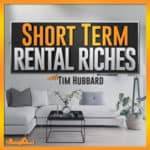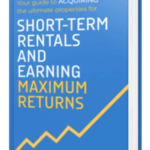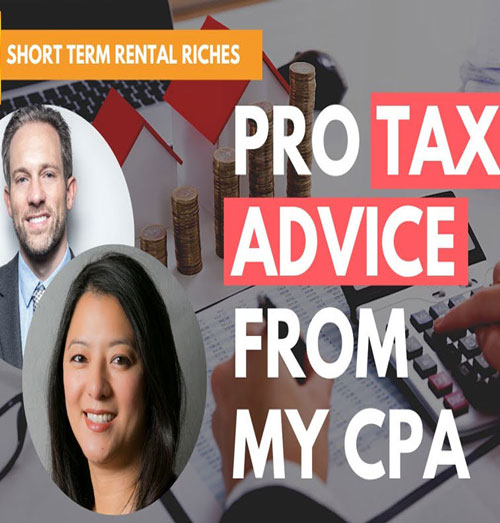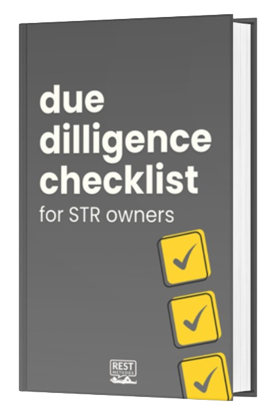Discover the Ultimate Guide to Finding Profitable Airbnb Properties in 2025: Expert Tips for Maximizing Profitability in the Short-Term Rental Market
Finding profitable Airbnb properties in 2025 might seem like a challenge, but it’s far from impossible with the right tools and strategies. Today, we’re joined by Airbnb investing expert Jon Bianchi, who has helped direct over $90 million in STR investments across 200+ properties. From real estate data analysis to selecting the right markets, Jon has fine-tuned a process to identify cash-flowing STR properties that outperform others.
In this episode, we break down Jon’s strategies for using platforms like AirDNA for STR market analysis, optimizing amenities to attract guests, and avoiding risky real estate markets. Whether you’re focused on boosting Airbnb income or expanding your real estate portfolio, this conversation delivers insights for STR success. If you’ve ever wondered how to turn your property into a revenue-generating asset, this episode is a must-listen.
In this episode, you’ll learn:
-
Effective STR Market Analysis: Learn how to use AirDNA and other tools to identify profitable short-term rental markets with potential for cash flow.
-
Key Amenities for Success: Discover the must-have amenities that make your property competitive and the nice-to-have features that set you apart.
-
Avoiding Risky Real Estate Investments: Identify oversaturated or underperforming markets to avoid costly investment mistakes.
-
Boosting Airbnb Income: Optimize your STR listings with better management, guest experience, and strategic amenities for maximum revenue.
-
How to Find Cash-Flowing Properties: Understand price-to-rent ratios and the importance of full-time hosting data for STR property selection.
Unlock Profitable Airbnb Opportunities with John Today!
—
Need help managing your short-term rental and you don’t want to go it alone? Shoot us a message here and we’ll see if we can help.
Are you enjoying the podcast? Please subscribe, leave a rating and a review, and share it! This helps us reach others that may find the info helpful as well.
You can find all of our links here including our website, recommended resources, upcoming live event, short-term rental playbook, Instagram, and more!
Click Here to view TranscriptA lot of you reach out asking if I can help review a property that you’re interested in or if a market makes sense.
And as much as I would love to, it takes a lot of time.
So I’m really excited for our guest today, John Bianchi.
This is what him and his team do, and we’re gonna dive into the details.
Everything that you need to know to find a profitable property in 2024 and 2025, we’re gonna cover what makes a property profitable, what amenities you need to use, and what you can live without.
We’re gonna talk about what good data looks like.
So if you’re using some data tools to help underwrite or analyze a property, well, not all data is the same, right?
And so I’m really excited to jump into that, as well as some properties, some markets you should avoid, when you know that you should actually pull the trigger on a property when it makes sense to sign on the dotted line.
I’m really excited.
Stay tuned.
You’re gonna learn a ton.
And if you’re looking for a property out there, believe me, you’re gonna want to hear these insights.
Welcome back to the Short Term Rental Riches Podcast.
I’m happy you’re here again.
And I have a special guest today, Jon Bianchi, who specializes in finding cash flow properties.
Now I know what you’re thinking, cash flow properties in 2024, 2025, that’s hard to come by, but they are out there, believe me.
And him and his team have been specializing in this for a while.
They’ve direct over $90 million in investment, close to 200 properties or maybe more than that at this point, that are all cash flowing.
So I’m excited to jump in with Jon Bianchi.
Welcome to the show.
Thanks for having me.
Cash flowing properties definitely still exists.
It just takes a lot more work to find them.
Indeed, indeed.
I, you know, kind of going back a little bit, this show, I started years ago when it was a lot easier to find cash flowing properties.
You know, the name Short Term Rental Riches sort of suggests that they’re riches to be found with short term rentals.
And a lot of people don’t really think that these days because prices are higher, mortgage rates are higher, and it’s more competitive.
So a lot has changed.
And I know you guys specialize in this.
So I’m excited to jump in to it with you, Jon.
Do you want to give us just a real quick background?
I guess how you got in and then we’ll take it from there.
Yeah, sure.
Thanks.
So I started off with Airbnb pretty well.
How majority of people do is, you know, you learn about it online, you give it a shot.
I rented out my fair room when I first got started, which was an adventure of its own.
And then decided that I wanted to turn this into a business and started looking into getting more properties, you know, rental arbitrage route, property management route, just, you know, did have enough money to buy my own property at the time.
And eventually got to the point where we’re at about 15 plus Airbnbs out of Chicago, a couple down in Scottsdale, had a couple over in Michigan as well.
And good old COVID came around and wiped that all out.
So I was able to sell off the contracts, which was nice and helpful.
However, I was kind of left with all of this knowledge about Airbnb and no Airbnbs.
And I obviously wanted, I loved Airbnb in the whole industry as a whole, but I realized that the thing I did better than anything else was actually understanding Airbnb data to know which properties to get and which ones to not get.
And for whatever reason, I just fell in love with that.
And I did it better than I did anything else, right?
When it came to like operations, I was okay, I could make it happen.
But like, I know some guys who have like 400 properties and they scaled it as fast as it took me to get to 15, right?
So there is a huge difference.
And data was just the thing that I did best.
So I honed in on it and I practiced it and I started helping other people.
And then eventually I got a contract with TechFester, which is now the largest short-term rental investment fund in America.
And for about two years straight, every single day, all I got to do was just analyze Airbnb data and try to allocate investments into these properties, trying to prove out that my process that I created on this rental arbitrage model was going to work for finding properties we could actually purchase.
And looking back at it, it’s been about almost three years now since then, and I’ve helped TechFester find 150 plus properties.
Every single last one of them is cashflow positive.
The process worked.
The thing that I got to do worked really well, and I got to make a name for myself a little bit as the Airbnb data guy because of that opportunity.
And since then, just been helping people outside of the institutions, just retail investors as well.
That’s a bit of the background, how I got to doing what I’m doing and a bit of the track record as well.
Awesome.
And just for our audience listening, I sort of got connected to Jon in sort of a back door way.
So we’ve been managing properties around the world at this point, and one of our newest partners sent over an estimate that he had received from Jon’s company, STR Search, and he said, hey, what do you think about this?
He already owned the property and he was renovating that, but he wanted to get the most out of it.
And we know that one property can earn much more than its neighboring property if it has the right amenities and it has a lot of the right pieces in place.
So we’re going to jump into that, but I was impressed with the report.
And so John and I got connected and I’m excited to have you on the show today, John.
And I also love data.
I love data as well.
And we talk about that a lot on the show, pricing and revenue management, sort of on the back end after you’ve acquired the property, but it all starts with making sure that we have a property that has opportunity and that we can cash flow.
It’s the name of the game, right?
So let’s go ahead and jump in to a few questions here.
First one, how do you know when you’re working with good data?
I talk about this on every single podcast I’ve ever done.
It’s the one message I’ve probably repeated the most because it’s so, so important.
So, you know, a lot of people even listening to this might not even realize that there’s bad data out there, right?
Or information that you shouldn’t use.
Or maybe they’ve gone on to AirDNA and tried to make sense of it and said, AirDNA is crap, it makes no sense and it’s useless, right?
I’m living proof that that’s not the case because I’ve used AirDNA this entire time and we found all those properties.
The reality is that you have to know what you’re looking for and what to avoid.
And on AirDNA and every other site, but I just mainly use AirDNA, there’s good information, there’s bad information.
And I always like to start off with what do we consider good?
Because it gives you like an idea in your head of what to look for.
And good is simply a full time host that has been tracked by AirDNA for almost a full year.
It’s that simple, right?
So you got to find the combination of those two things.
And if you’re on AirDNA, they have this little metric there that tells you how many days it’s been available, which is also how many days that they have been tracking it.
And so I always want to see that number over 250 days because that’s almost a full year.
And when it’s almost a full year, their revenue predictions are as accurate as I like.
I feel good about how accurate they are in comparison to if the property has only been around for 30 days and they’re trying to predict what it’s going to do over the full year.
Right.
So that’s the first thing you want it to be tracked by AirDNA for almost the whole time.
Now, the other part of are they a full time host is a really big deal.
Because a part-time host can also have their listing tracked by AirDNA for almost a full year.
And AirDNA does a poor job of knowing if a listing is part-time or full-time.
And then all of a sudden, the revenue numbers that they’re predicting are all over the place, right?
So the other thing that you need is a full-time host.
And the way that I have gone about checking to see if they’re full-time hosts or not are within the reviews.
So at a minimum, I want the listing to have at least 20 reviews because if you’re going to manage Airbnb over the full year, you almost get 20 reviews no matter what, right?
Very, very low number.
And so then the other thing is I want to make sure there’s a review every single month for the past 12 months.
And if I can see that, then I know that they have been hosting that entire time.
And then therefore their revenue number is based off of a full-time host managing this as a business and AirDNA has been tracking them the whole time.
And now I know I’m looking at useful, good data.
And that’s pretty well it, yeah.
Okay, so some great points there.
The first one, yeah, Active Nights.
This is something that we look at all the time as well.
You know, when we’re pulling a comp set for a property that we already own or that we already manage, because we want to make sure again, we’re kind of comparing apples to apples.
There are a lot of markets where properties are seasonal, you know, and maybe being owners coming in for three months out of a time, and that’s very common.
But again, we want to be comparing with what, like how we can maximize the revenue with this property, right?
And so looking for full-time hosts, that’s a great tip.
For those of you that don’t know, I think most of you that listen to the show, you’ve heard me say AirDNA a whole bunch of times, but it’s a very useful tool that has a whole bunch of data.
It’s scraped, you know, so they’re pulling it offline.
And as John’s saying, we got to know how to filter through it.
So good stuff there.
So first, we got to start with good data.
I know there’s probably a few people thinking out there too, John, they’re like, I can’t, I don’t have any comps in my area, you know, or I can’t find properties.
If I limit them to 20 reviews, there’s not going to be a whole lot.
And we can get into this, but I’m sure that’s part of the reason why you don’t actually look in every single market in the whole United States, right?
You and your team sort of specialize in more specific markets, if I understood that right?
Well, yes.
But so we analyze, or sorry, we help people find properties in roughly about 10 to 15 markets.
And the way that I got to those 10 to 15 markets is by studying over 350 markets.
And so we had to go through all of them to kind of get there.
But what you’re referring to are those really like rural areas where there’s just not a lot of other comps.
And I always say if there’s no data, I’m useless because I don’t know how to like figure it out, right?
And so, yeah, if there’s just no data there, there’s not a ton that you can do.
I could give one example if you want of like the way that I’ve kind of gone around that.
Would that be helpful?
So I can’t remember what state it was in, but it was one of the states where there was a lot of empty land, I guess you could say, kind of like right in the middle of America.
And there was this little resort.
So it was like three or four buildings in this one area on a whole bunch of acreage.
It’s kind of a cool spot, right?
But there’s no data around, like nothing.
And so the way that I decided to go about this was analyzing almost all of the properties in the state that fell into a similar bucket of that property, meaning I took the whole state and I would go avoid all the cities, avoid all the small towns, avoid anything that was a little vacation town.
And it was like anybody else in that state that had a little, you know, an Airbnb in the middle of nowhere.
And there were a good amount of them because of that type of state, right?
And so eventually I was able to gather enough data to kind of find a pattern.
So even though they were all over the place and fairly far away from each other, like hours from each other, they had a similar blueprint, I guess you could say, like a similar, they were a similar type of property with similar type of offering in a similar type of location.
And so there’s a lot of similarities to it.
And to me, like that was enough to be able to understand what this property could do.
And then when you do that, you actually do end up getting enough data that you can find some sort of consistency from the one bedrooms or the three bedrooms and the way that the properties look.
You can see like, okay, they’re falling within this range.
Like, it’s not like they’re all over the place, right?
And they go, okay, well, the properties are in this range.
Now I have a three bedroom that’s in this area that generally falls within that blueprint and it likely will fall within that range as well.
So that’s how I did it on a spot with very, very, very limited data.
Yeah, we have to work with what we have, right?
So, I mean, if we’re looking at an investment, obviously, the more data we have, the more we could accurately estimate how that property is going to do.
And so there are a whole bunch of cities and suburbs and hundreds, thousands across the US.
You guys have narrowed down to quite a small amount, you know, let’s just say there’s 350 MSAs in the US.
You guys have narrowed down a lot of those.
So how do you decide if a market is worth deep diving into and potentially investing in?
Okay, so it’s quite a process, but I’ll try to break it down high level.
I’ll always start off with, you know what?
I’ll keep it super simple.
First, have good regulations.
I know this is a data conversation, but the amount of times that I’ve analyzed an entire market just to realize that the regulations are not going to allow for it in the first place, just makes it a ridiculous amount of waste of time, right?
So figure out that they got good regulations in place already.
And then step two is just try to see if there’s some cash flow.
So that’s what I always start off with, because in the Airbnb industry, if your property doesn’t cash flow, you’re probably going to sell it.
It’s a lot of work, right?
Like, you know, it’s not like a long-term rental where you just get somebody in there, it breaks even, and you just bank on appreciation.
A short-term rental is way more work.
You got to put a lot of money up front into the properties and the amenities, and so you want to be able to make that money back, and you make that back pretty well through the cash flow.
Now, you still want a good market that appreciates, right?
And a good property and, you know, good regulations for the entire area.
Like, you still want those core concepts of real estate in general.
But I find that if you can, you know, anchor in the cash flow as well on top of that, it allows you to be able to keep the property long term, and you still get all those benefits of appreciation and everything else that comes along with it, right?
I’ve dedicated years and hundreds of thousands of dollars through trial and error to figuring out how to manage my personal portfolio remotely.
And it wasn’t always easy, and it took a long time.
But now, my amazing team can professionally manage my properties without me.
And good news, our team can also manage yours.
Let us save you the stress and headaches and some money by offering you an industry low fee.
To find out more about partnering with us, head to strriches.com, hit the property management button, answer a couple quick questions and meet with me personally.
That’s strriches.com.
Rest easy knowing that with my team, your properties will be in excellent hands.
So step one is regulation.
Step two is, is there any cash flow in this market?
Right.
The way that I try to find cash flow in a market is I look for the price to rent ratio of homes in that area.
Okay.
So I’ll go and look and I’ll try to understand how much the homes are generally making and I’ll try to find some on a short term basis.
Yeah.
How much are they making?
How much are the AirBnbs making over an entire year?
And I’ll look between the three bedrooms and the five bedrooms and I’ll try to find like the normal homes.
So like I’ll avoid luxury, I’ll avoid unique, I’ll just look at the regular old homes.
How much are those generally making?
And if I realize that they’re generally making about, let’s say, $100,000, okay.
Then what I want to do is I want to find homes that are for sale or recently sold that are around $500,000.
And that’s a 20% price to rent ratio.
So meaning that the home that’s cost $500,000 to purchase can make about $100,000 or 20% of its purchase price.
And if I can find that, right, even just once in a market, I was talking about this yesterday with somebody, just one property that can do that.
I know that there’s cashflow in that market.
I know that there’s a way to be able to make a profit from the Airbnb.
And at that point, it’s my indicator to go, that’s a market.
We should deep dive, because deep diving a market could take like a week, right?
Deep diving Austin would take me like two weeks to do.
So yeah, so that’s the number one indicator.
Good regulations, a good price to rent ratio.
Awesome, okay.
Yeah, for looking for cashflow, the purchase price plays a huge piece in that, right?
But if we’re using financing, that makes properties much more easier to acquire for a lot of people.
When you are running your sort of general analysis on a market, are you considering financing at all?
For sure, yeah, every time.
Almost everybody that I work with is financing the property.
If they don’t, it’s easier to cashflow, because you don’t have to pay the debt.
But almost nobody has, you know, half a million to a million to throw out a property and pay all cash for.
So yeah, we’re always considering financing and every other expense that you’re going to run into, right?
The cleaning fees and the utility fees, the Netflix bill, like all of those things are considered in the equation to then come out with, is it going to cashflow or not?
Okay, so when you’re narrowing down these markets, let’s say the estimated revenue is $100,000, you have some sort of like back end calculations on, you know, what the average mortgage might be and property tax.
And are you sort of calculating those things in on the back end?
Yep, at the beginning though, so going through 350 markets is a lot to go through if you’re gonna deep dive them or do exactly what you just sort of mentioned.
So all I’m looking for is the ratio.
So at the very beginning, I’m not figuring out the property taxes for that $500,000 home that I’m looking at.
I’m just simply trying to see, okay, that’s a $500,000 home, and it’s a log cabin, and it’s a four-bedroom, three-bath, and it’s got an acre of land.
And then I can see that there’s an Airbnb that exists in this market, that is a log cabin with an acre of land, and it’s making about $100,000 a year.
And I go, that ratio, which is 20%, right?
I go, okay, that’s a good ratio.
Because if you plug that ratio into an underwriting sheet with almost any expenses across America, it’s almost always gonna cash flow at that amount.
So that’s a special point.
Yeah, I was just thinking back to, before I got into short-term rentals, I was investing a lot in long-term rentals.
And we used to use the same ratio for long-term rentals.
And back in the day, we were always searching for this 10% rent-to-price ratio.
So $100,000 property could get $1,000 in rent a month, basically.
It was kind of the breakdown there.
So the 20% is the special mark for you looking for short-term rentals.
Correct, yeah.
And I always have to state to people, because people get this confused all the time, it’s not cash-on-cash that I’m referring to.
So it’s price-to-rent ratio, right?
Not cash-on-cash, just price-to-rent ratio.
And then it’s going to cash-flow in amount that I’m typically happy with, right?
You can find properties that meet the 15% ratio.
So you buy a million-dollar property, it makes $150,000 a year.
For some people, they’re very happy with that.
And for some people, that works.
Like they’re taking advantage of the taxes, whatever it may be, they could care less about the cash-flow.
And that works, right?
For myself and what I’m trying to do and what I’m looking for, those are my indicators.
Gotcha.
Okay, so just to recap here real quick, we got to start with good data.
We got to make sure we’re looking at the right numbers.
There’s a whole bunch of markets to choose from, but you’ve narrowed them down considerably, at least you and your team and the markets you generally look at.
Looking for that 20% rent-to-price ratio, so $500,000 home is making $100,000 in revenue.
And so that’s a really good starting place, right?
And you guys have proven that.
But after we have the property, we know that $10,000, $500,000 homes could all make drastically different amounts.
And so some important things, there’s some really important pieces there, right?
Obviously management and reviews.
But in terms of the actual property, amenities can make a really big difference.
And so how do you know which amenities are most important and maybe which ones you might consider adding if they’re not already in the property when you purchase it?
I love this stuff.
I’ve been starting to think of myself as a cashflow optimist.
You know what I mean?
Trying to optimize for cashflow as best you possibly can.
Just to give an example, because I think this is the biggest example before we go into the whole story.
TechFester, the company I was referring to, I talked about this publicly a ton.
They have two properties that are down the street from each other.
They’re both four bedrooms within a certain market.
And I’m not kidding, down the street from each other.
And one makes $100,000 more than the other one.
And even their backyards are similar sized, right?
But it’s the way that the amenities were put in, the certain amenities that were used.
And the crazy part too is like, they almost have matching amenities.
So there was even like another step.
And when I say $100,000 more, the first one is still profitable.
The other one just makes another $100,000 on top of what that one was making, right?
So, and almost purchased at the exact same price.
So crazy.
Totally believe it.
I mean, I totally believe it.
Yeah, and I see it.
I have lots of properties in my own portfolio that are really easy to do A-B tests, because they’re like in the same building.
They’re maybe not exactly the same, but they’re furnished a little differently.
So I see this and yeah, I’ve got you.
Yeah, yeah.
I’m glad you believe me.
It is true.
So amenities are a huge deal.
Amenities can make or break a listing.
Obviously you gotta get the right property to begin with, but then the amenities can really change your cashflow.
So a couple of things I want to talk about here.
First off is how I think about investing in two amenities, okay?
The next thing is going to be demographics.
And then the third thing is going to be must have versus nice to have.
I’m not sure if I’m going to go perfectly in that order, but I want to cover all three of those things.
So the first thing I want to mention is that I have not found anything that will tell me exactly how much an amenity will make due to the amount of variances in the data.
Okay.
So what I mean by that is I haven’t figured this out and I’ve seen a lot of other people try to figure it out.
And I just don’t believe what they’re showing.
In other words, I can’t say that if you had a hot tub in this market, you will make $10,000.
I’ve never been able to prove that because there’s so many variables to why one listing is doing more than another listing all the way down to the order of the photos, the pricing of the property, the color scheme that they used, how well the photos were taken in comparison to the other person or how well they were edited.
And you can go on and on and on.
And there’s so many variables to each and every listing that to say that the hot tub is the one reason that the listing is making $10,000 more than the other listing is inaccurate to say, as simple as that, right?
So, right.
And so then therefore, if that’s the case, we don’t know how much a hot tub is going to make if we add it in there.
So how do we know if a hot tub makes sense to add it or not?
Right?
And I always say that I’m going to skip over the demographics.
I’m going to jump right to the must have versus nice to have.
So this has been my logic.
There’s certain amenities that you must have and there’s certain amenities that are nice to have.
The must have amenities are the amenities that all of your competitors have.
So if you need to make $100,000, right?
And there’s five properties all making $100,000, you got to figure out exactly what they have and what they don’t have and make notes on it and list it out.
You go, okay, well, four of them have hot tubs.
They all have pools.
They all have pool heaters.
Three of them have putting greens.
You know what I mean?
And they all have cornhole.
And it’s like, okay, well, if they have, if they all, if my competition has all of these things, I need those things to even be in the same realm as them.
Because when a guest is going to look for a place to stay, they’re tallying up what they’re paying for.
So it’s like, okay, I could go stay at this place.
And it’s giving me a bedroom, a bathroom, a kitchen and living room.
But if I get this other place, I’ll also get a hot tub of putting green, a pool, a pool heater and cornhole.
And if you don’t have those things, then the guest who’s going to pay for that listing is gonna see your place worth less and you’re not gonna make as much.
And so then therefore, if you need to make $100,000, you gotta be competitive with all of them.
And those are your must have amenities.
And if you’re on a budget, you start with those.
You don’t try and get creative, you start with those.
Because those are the things that people want.
Those are the things your competition has.
That’s what matters to the people going to that market.
So that’s step one, right?
Then the next part is nice to have.
Well, what sets me apart from my competition, right?
Nobody has a mural.
Okay, I could get a mural.
It’s not really amenity, but that’s money you’re putting towards something to make your listing shine, right?
Nobody has a jungle gym in their backyard.
Nobody has X, Y, Z, whatever it is, they don’t have it.
And so that is a nice to have, but it’s gonna give you a competitive edge over everybody else.
Now, this comes back to the question of, well, once we get to the nice to have, it’s like, well, should I get a bouncy castle in the backyard, or should I get a pool table, or should I get a $20,000 putting green?
Like, how do I invest my money in the best possible way?
And I believe this, and I want somebody to prove me wrong because then I can learn from them, but there’s no way to know exactly how much more you will end up making.
All we know is that it’s gonna give you a competitive edge over your competition.
And so having a competitive edge over your competition is a big deal.
And if you can do that, then there’s opportunity for you to make more.
We just don’t know how much more.
And the reason I’m such a stickler about this is because we went into one market where everyone was basically making $80,000, like our competitors making $80,000.
We did so much more than them, like a ridiculous amount more, designed so much better.
The backyard was loaded with the fire pit and the pergola and like sunbathing and like all of these things that nobody had in this market.
And we made about 90,000 off of the property.
So we made like a $10,000 jump over everybody else, which was very incremental.
Now we were okay if we made $80,000, but we wanted to get a bigger return for doing so.
The problem was that this market had a price anchoring.
People weren’t willing to pay an arm and leg to stay there.
They’re only going to pay so much to go to that market.
It’s nice that you have these options.
We’ll stay at your place instead, but I would have paid the same to stay there because that’s just what I’d pay to go to this market.
And so that was a reality.
And so in other words, if I had gone there and been like, oh yeah, we’ll make $40,000 more because we have so much more over these people, how could we not?
I would have made a huge mistake.
However, we have other markets we’ve gone into where we’ve quite literally made $100,000 more than our competition.
And the example that I just gave you as well was that was our own home.
We are competing with our own home and we made $100,000 more.
But another one I’m trying to say is that there’s some markets that don’t have that price anchoring that you really don’t know how much more you could expect, but that does then set the bar and you go, OK, well, this is the new norm.
Now we can have an idea of how much more we could expect by adding these amenities because we have a test property to prove it out.
And just to even go further in that, that first market where we went from 80 to 90, we have not bought a single other property in that market since we realized that, right?
Because it just wasn’t a good return on our investment.
Still worked, but we could get a better return somewhere else.
So again, bringing this back to what’s nice to have, right?
And then the last thing I want to say here, because I don’t think enough people think about it this way, is if you market to everybody, you market to nobody.
And so when you’re trying to decide what nice to have amenities you should get, think about which demographic would be the best to create an experience for.
So if you’re going to focus in on a bachelorette trip, you want to get a lot of things that are pink and over the top and create this sort of bachelorette experience that’s going to make it an even better experience than staying at any other Airbnb for the bride, right?
However, if you’re going to do that, you’re probably not going to add in a jungle gym for those ladies, right?
Because that wouldn’t make any sense.
So then therefore, what you’ll do if you’re focusing on kids, though, you would get a jungle gym.
And so understanding who your demographic is, when you start to go into that nice to have category, will help you allocate your dollars better to get a better return.
Gotcha.
Wow.
So much good stuff from Jon.
If you’re out there looking for property, I know those tips will help.
And those are essential tips.
And we have more for you.
But as you know, this podcast is short, quick and actual.
At least that’s the way I try to keep it.
And so we’re going to stop for today.
And I’ll see you back next week as we wrap up what you really need to know to find a profitable property and what you need to know to make sure you’re not getting in a property in a bad market or one that doesn’t make sense.
And how to know when you should be confident enough to actually purchase a property.
So stay tuned until next week.
I’ll see you then.














